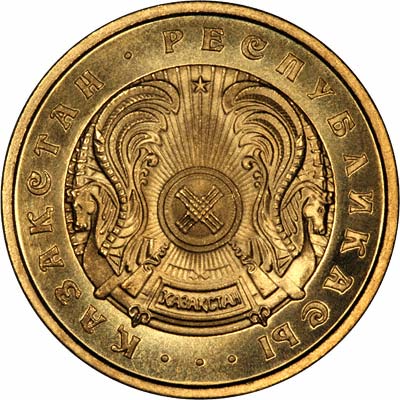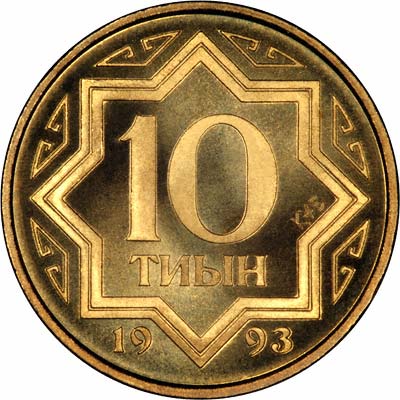| The Very Highest Quality Information... |
| Kazakhstani Coins |
|
| ||||||||||||||||||||||||||||||||||||

| ||||||||||||||||||||||||||||||||||||
|
| ||||||||||||||||||||||||||||||||||||

| ||||||||||||||||||||||||||||||||||||
Early History
Kazakhstan consists largely of steppe, and horse-riding nomads have dwelled within the Kazakh steppes since ancient times. A settled population was established in number of cities lying along the Silk Road that passed through the Kazakh steppes, including Taraz, Otrar and Turkistan, in order to serve as way stations for passing merchants.
From 448-1048, the Turkic Khazar Empire dominated what is now western Kazakhstan.
During the 8th Century, Southern Kazakhstan was on the fringes of the Abbasid Caliphate, and Islam was introduced to the area as a result. A struggle between various nomadic tribes eventually saw the establishment of the Kara-Khitan Empire under a Mongol Confederation of the same name. This Mongol Khanate was eventually supplanted by another Mongol Empire, that of Genghis Khan between 1218 and 1221. Following the death of Genghis, the area fell under the control of the successor Golden Horde, this fractured into other khanates until finally, in 1 465, what is now Kazakhstan fell under the control of the Kazakh Khanate and the concept of the Kazakh nation was born.
Kazakh Khanate
The Kazakh Khanate was established under its first Khan, Janybek, who splintered away from the Uzbek Khanate following a rebellion. Under Janybek’s son, Kasym established a codified system of laws for the new nation state.
The Khanate was divided into three administrative regions, known as ‘jüz’, all under one common Khan. However, the jüz gradually became more and more autonomous. The Kazakh Khanate managed to preserve its independence from expansionist rival Khanates, and later from Russian and Chinese encroachments until the 19th Century. In 1822 Tsarist Russia managed to establish control over Kazakhstan.
A final rebellion by Kenesary Khan between 1841 and 1847 ended when Kenesary was betrayed and murdered by a subordinate, who was rewarded handsomely by the Russians for his perfidy.
Russian Rule
Russia had been establishing settlements in Kazakhstan since before the end of the Khanate. The Russian settlement of Orenburg (later renamed Orsk) was established in 1735. Throughout Tsarist Russian rule, Russia attempted to russify Kazakhstan by encouraging Russian settlement and the use of the Russian language in government institutions and schools.
Throughout the course of the 19th Century, millions of settlers from other parts of the Empire, particularly Russians, arrived in Kazakhstan.
This was greatly resented by the Kazakh population, who rebelled on more than one occasion against their Russian rulers, but ultimately without success.
Kazakhstan under the USSR
In 1916, a Central Asian revolt broke out within the Russian Central Asian provinces, including Kazakhstan. This revolt carried on after the Russian Revolution and the rise of Bolshevist rule. Although the Central Asian revolt carried on elsewhere, Kazakhstan effectively came under Bolshevik control after 1919, and the Kazakh Soviet Socialist Republic was established the following year.
Soviet Kazakhstan suffered from famine in the wake of Stalin’s policy of forced collectivisation during the 1920s and 30s, leading to many deaths from starvation. Stalin also instituted a somewhat more intense policy of russification by systematically murdering or deporting Kazakh writers, poets and other intellectuals in an attempt to destroy a separate sense of Kazakh identity. Kazakhstan also became a destination for deportees from other parts of the Soviet Union who were sent to gulags established there for people found guilty of crimes against the Soviet state.
In the late 1940s, Kazakhstan was also chosen as the location for open-air testing for the Soviet nuclear weapons program, which contributed to a rise in cancer in the area around the city of Semey.
In spite of this, Kazakhstan became one of the last Soviet Socialist Republics to gain full independence following the collapse of the Soviet Union in 1991.
Kazakhstan Today
Since independence, Kazakhstan has been ruled by President Nursultan Nazarbayev. Officially, Kazakhstan is a democratic (in the non-ironic sense) presidential republic that host regular elections, but Nazarbayev’s election results giving him in excess of 90% of the popular vote in every election since 1991 are a dubious indication of the true extent of the government’s democratic legitimacy.
In addition, the president has been accused of corruption and human rights abuses, including the assassination of Altynbek Sarsenbayev, an opposition leader.
The ‘Borat’ Incident
In 2006, a film called ‘Borat: Cultural Learnings of America for Make Benefit Glorious Nation of Kazakhstan’ was released by British comedian Sacha Baron Cohen, with himself starring in the eponymous role. The film gave a ludicrously over the top depiction of Kazakhstan as a primitive nation of bigoted, ill-educated sexual perverts, with Baron-Cohen playing the role of a ‘Kazakhstani’ journalist afflicted with all of these flaws. It is not really known why Baron-Cohen settled on Kazakhstan as the nation of origin for this fictional character depicting a stereotypically backward and poorly educated foreign journalist, but the film nevertheless caused grave offence in Kazakhstan, which not only banned the film, but also caused a diplomatic incident to break out with Britain and the US over the issue.
Official protests against the film and its depiction of Kazakhstan, coupled with attempts to have it banned globally served only to encourage the ferociously iconoclastic comedian to step up his satirical attack against the country. However, it also provoked some debate within Kazakhstan on issues such as censorship and whether or not the country and its government takes itself too seriously.
Coinage of Kazakhstan
During ancient times, the Spice Road passed through Kazakhstan, and the passage of Merchants from Ptolemaic Egypt, Rome and India saw the use of coins of the merchant’s respective homelands circulate in waypoint cities such as Taraz as the merchants passed through.
The Khazars, converts to Judaism who ruled over western Kazakhstan, issued an Arabic-style coinage of silver dirhams which was virtually identical to the coins issued under the Abbasid Caliphate, save for the proclamation that Moses, rather than Muhammad, was the prophet of God. These coins also circulated far beyond the borders of the Khazar Empire have been found in hordes as far away as Sweden.
It is known that the Mongols struck dirham-style coins in Taraz until the late Middle Ages, and that Otrar also minted its own coins up until the 13th Century.
During Tsarist Russian rule, the Russian rouble was introduced into Kazakhstan until it was replaced with the Soviet rouble in 1919.
Following independence from the Soviet Russia, Kazakhstan introduced its own currency, the ‘tenge’ (which means ‘scales’ in Kazakh) in 1993. It was subdivided into 100 tiyn. In 1993 coins of 2, 5, 10, 20 and 50 tiyn and 1, 3, 5, 10, and 20 tenge were issued.
The tiyn subdivision has since been rendered obsolete by inflation, and the 3 tenge denomination has been discontinued. Today coins of 1, 2, 5, 10, 20, 50 and 100 tenge are issued for circulation, issued in brass for denominations up to 10 tenge, cupro-nickel for 20 and 50 tenge and bimetallic brass/cupro-nickel for 100 tenge.
Coins feature Kazakhstan coat of arms on obverse and denomination on the reverse.
For Sale and Wanted
If you are interested in coins from Kazakhstan please see our product index:-
Kazakhstani Coins
Gold Coins
We also have gold coins from Kazakhstan on our taxfreegold website:-
Kazakhstani Gold Coins
| ...at the Lowest Possible Price |
|
32 - 36 Harrowside, Blackpool, Lancashire, FY4 1RJ, England.
Telephone (44) - (0) 1253 - 343081 ; Fax 408058; E-mail: info@chards.co.uk The URL for our main page is: https://24carat.co.uk |
Web Design by Snoop |